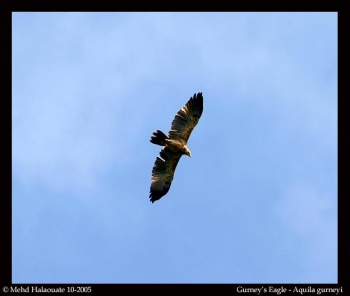- Aquila gurneyi
Identification
66–86 cm, 26-33.9 inches.
Wingspan 165–185 cm. Immature female 3060 g
Adult
- plumage overall blackish-brown
- Cere grey brown
In comparison to other Aquila:
- tarsal feathers paler
- legs slimmer
- wings shorter (e.g. cf Black Eagle which this species most resembles)
- secondaries bulge outwards
- flight feathers often with whitish markings
- tail long
Juvenile
- Browner above with grey brown marbling
- Underparts getting lighter with creamy abdomen and legs
- Third and fourth year plumage has less marbled upperparts, lighter brown or cream head and underparts
Similar species
- Wedge-tailed Eagle has:
- Less yellow feet
- Shorter, less rounded tail
- More reddish brown in colour
- In Moluccas the Black Eagle is different for the following reasons:
- it averages slightly smaller although with extensive overlap in measurements (65-80 cm—compare with Gurney's above)
- its wings are narrower at the base giving a more paddle-shaped appearance
- its wings have a less distinct secondary bulge
- the bird's primary "fingers" are more pronounced than Gurney's
- it has variable amounts of white on the rump, around the beak, and eyes
- Black Eagles have a more distinct white patch at the base of the primaries (not always visible)
- Their bare parts are darker yellow
- Their iris is darker yellow (brown changing to pale yellow in juveniles)
- Juvenile White-bellied Sea-Eagle normally has a much paler rump, underwing and undertail
Distribution
New Guinea, the Aru Islands and northern Maluku (Moluccas). Recorded in the Cyclops Mountains, on Biak Island and the Vogelkop Peninsula in Irian Jaya and near Vanimo in Papua New Guinea.
Taxonomy
This is a monotypic species[1].
Habitat
Coastal and swamp forests and forest edges.
Behaviour
Solitary or in pairs, occasionally in threes, but this thought to be family groups
Diet
Small mammals, such as cuscus and woodland possums. Forages by soaring low over the forest canopy and open spaces. Is known to use thermals along cliff edges and hillsides.
Breeding
They are known to build a large stick nest high in a tree, but little other information is available.
Vocalisation
A nasal sound of medium to high pitch (but descending) with a piping quality, is repeated about once per second.
References
- Clements, J. F., P. C. Rasmussen, T. S. Schulenberg, M. J. Iliff, T. A. Fredericks, J. A. Gerbracht, D. Lepage, A. Spencer, S. M. Billerman, B. L. Sullivan, and C. L. Wood. 2023. The eBird/Clements checklist of Birds of the World: v2023. Downloaded from https://www.birds.cornell.edu/clementschecklist/download/
- Debus, S., G. M. Kirwan, and J. S. Marks (2020). Gurney's Eagle (Aquila gurneyi), version 1.0. In Birds of the World (J. del Hoyo, A. Elliott, J. Sargatal, D. A. Christie, and E. de Juana, Editors). Cornell Lab of Ornithology, Ithaca, NY, USA. https://doi.org/10.2173/bow.gureag1.01
- Raptors of the World, James Ferguson-Lees and David Christie. ISBN 9780713669572
- Debus, S., G. M. Kirwan, and J. S. Marks (2020). Gurney's Eagle (Aquila gurneyi), version 1.0. In Birds of the World (J. del Hoyo, A. Elliott, J. Sargatal, D. A. Christie, and E. de Juana, Editors). Cornell Lab of Ornithology, Ithaca, NY, USA. https://doi.org/10.2173/bow.gureag1.01
Recommended Citation
- BirdForum Opus contributors. (2025) Gurney's Eagle. In: BirdForum, the forum for wild birds and birding. Retrieved 3 April 2025 from https://www.birdforum.net/opus/Gurney%27s_Eagle
External Links
GSearch checked for 2020 platform.1





